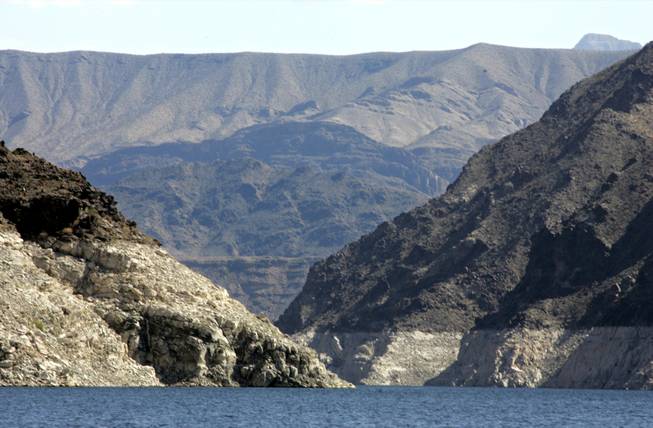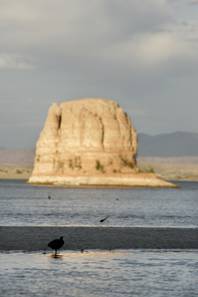
Sam Morris / Sun File Photo
Discoloration around the banks of lake mead shows how much the water level has declined over the years. Lake Mead is currently over half full, its water supply has been depleted due to an ongoing drought and the demands put on it by the growing community in southern Nevada.
Sunday, Oct. 9, 2011 | 2 a.m.
View more of the Sun's opinion section
Last November, the water level in Lake Mead dropped to a place it hadn’t been since 1937 — when the lake was originally being filled.
A long drought and population growth in the Southwest had taken a toll: Lake Mead had fallen more than 130 feet over the previous dozen years. That wasn’t good news for anyone who depends on the Colorado River, which feeds Lake Mead. Under the law that governs the river, if the lake’s elevation hits 1,075 feet, a shortage is declared, bringing about limits on how much water can be drawn out of the lake. Last November, the lake was within about seven feet of that mark.
A wet winter and good snow in the Rockies brought lake levels up, but that shouldn’t lessen the concern. The lake is still 114 feet lower than it was in 2000, and there is still the potential for it to drop again. A 2008 study by the Scripps Institute of Oceanography and the University of California, San Diego, said there was a 50-50 chance that Lake Mead could be drained by 2021 due to growth and climate change.
Although growth has slowed and Las Vegas has enough water for current needs, this is still a sobering situation. With the potential limits on Lake Mead, which provides about 90 percent of the water for Las Vegas, the region needs to prepare for the future.

A bird rests in Las Vegas Bay on Lake Mead at sunset Friday afternoon, April 21, 2006.
For more
The Southern Nevada Water Authority has been aggressive, not to mention creative, in trying to provide more water, and the state engineer is now holding hearings to consider the authority’s request to draw water from rural areas in Central Nevada. Under the proposal, the Water Authority would build an array of wells, pumping stations and a 300-mile pipeline to bring water to Las Vegas.
Environmentalists and others in rural Nevada and western Utah are vigorously opposing the authority’s plans. They say the project would harm the rural areas and argue the costs would be prohibitive. They also have claimed Southern Nevada doesn’t really need the water and suggest future water could be provided through further conservation efforts and building desalination plants on the Pacific Ocean in exchange for some of California’s share of Lake Mead.
However, in our analysis of the proposal, those arguments don’t hold up. For example:
• Timing: It is true the region doesn’t need the water immediately, but the Water Authority doesn’t plan to build the project until it is needed. Water officials are trying to get approvals now so they can move quickly in the future, and that’s wise.
• Environment: The Water Authority has made agreements with federal agencies to monitor the rural areas and work to mitigate any environmental problems.
• Cost: Opponents claim the pipeline will cost $15 billion, pointing to a number in a report done for the Water Authority, but that is a worst-case scenario. In a realistic scenario, the cost to build the project in today’s dollars would be under $4 billion, and the cost to water users in Las Vegas spread over decades would be reasonable.
• Conservation: Southern Nevada does a good job of saving and reusing water, and has been able to increase its supply by doing so. While there is room to do more, conservation alone won’t provide enough water for future use.
• Desalination: It sounds good but is incredibly expensive and uses an immense amount of power, and desalination hasn’t proven to be feasible at this point.
However, even if conservation or desalination were viable, they won’t help Las Vegas if Lake Mead’s water level drops and there’s a shortage limiting available water.
There are those who say Nevada should limit or stop growth, but that doesn’t make sense. Without more water, Southern Nevada’s future dries up, and that’s good for no one. The Water Authority has offered a solid plan. It should be supported.
•••
What do you think? Send your thoughts in a letter — no more than 250 words. Include the writer’s name, address and phone number. Anonymous letters will not be considered. E-mail: [email protected].

Join the Discussion:
Check this out for a full explanation of our conversion to the LiveFyre commenting system and instructions on how to sign up for an account.
Full comments policy